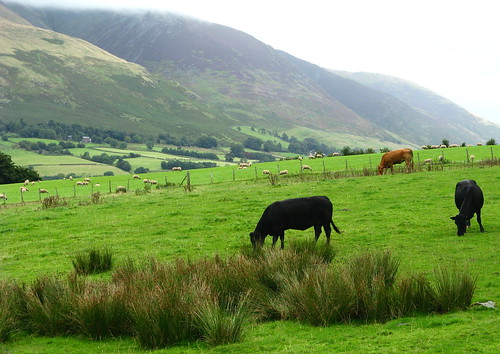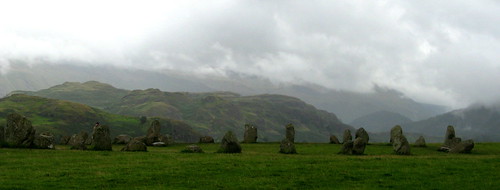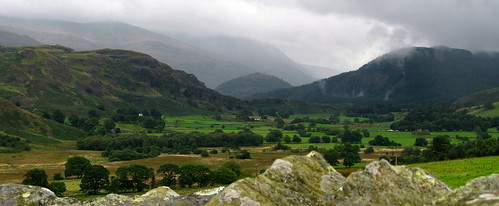Beautiful landscape calls us to dream and to wander, to take paths unknown. In it, we fix our eyes both on the distant horizons and on the tiniest details at our side. It reaches into our souls, rewards and soothes us. It is the Earth’s embrace.
Standing in an open field in England’s Lake District recently, I felt the Earth share its gifts of timeless beauty, wonder, and mystery. On a vacation trip with my partner Janne in August and early September, I sensed that it’s a place where humankind and the land have lived fairly well together for many generations, and where – in the words that a friend once said to me – “the land is happy.” Were the Lake District around the corner, I would go out to walk its fells – the mountainous landscape – and fields every day and show reverence. Though this space in England’s northwest corner is 3,200 miles away, its images are clear and alive in my mind.
For generations, the Lakeland has been the home of farmers and sheepherders and has drawn poets, writers, artists, and philosophers. Its landscape helped shape William Wordsworth, who lived here for much of his life. Capturing a moment overlooking the lake of Windermere, he wrote of his “exultation” at seeing “lakes, islands, promontories, gleaming bays, a universe of Nature’s fairest forms.” John Ruskin, the preeminent art critic, writer, and philosopher on society and the environment in the 19th century, made his home in Coniston. Brantwood, Ruskin’s home and gardens, is preserved and open to the public, as are two of the houses where Wordsworth lived in his adult years.
Author Beatrix Potter spent much of her early life here on holidays and became enthralled with the Lake District’s natural beauty and with its animal creatures. When proceeds from her books later provided the means toward independence, she bought a 17th-century farmhouse in the village of Sawrey, Hill Top (still preserved and open to the public). She became accomplished at sheep breeding, especially Herdwick sheep.
Passionate about conserving the Lake District, Potter bought up working farms and tracts of land. Upon her death in 1943, she bequeathed 14 farms and more than 4,000 acres altogether to the National Trust. As we took in the pathways, dales, mountains, lakes, and forest, the world of Wordsworth, Ruskin, and Potter felt very much alive around us, a direct line to the artists and thinkers of today.
Inviting Lands
Yes, the Lake District is firmly in the 21st century, with its sometimes traffic-congested towns, shopping mania, and Internet, its grocery stores with ATMs and fancy food, and its town posters promoting yoga and eco-concerns. Still, it has compact, walkable towns and none of the suburban sprawl that tells the Earth that our mindless spread and consumerism matter more than it.
The Lake District landscape feels timeless, appearing much the same as it has watched humanity come and go over generations. It is marked in late summer by lush green of many shades, rounded curves, and meadows of wildflowers. The land is bordered and dissected endlessly by stone walls that flow with its curves. The green fells feel cultivated and wild at once.
That it is this way is no accident. It is a combination of natural forces plus farming and herding over many centuries – in particular, sheep grazing. It’s also due to the continual work of many to protect this environment. Humans have raised sheep in the area since Roman times. Sheep grazing is vital to maintaining the unique openness of the fells, as the sheep eating the grass keeps it short and prevents the resurgence of forest. We saw hundreds of sheep in the fields and on the fells, literally all over the open country. I was amazed more than once at seeing small dots high up on the peaks of the fells only to discover, upon looking more closely, that the dots were actually sheep grazing, treading easily where relatively few humans go.
Geologic processes, from volcanoes to glaciers, long ago shaped the Lake District into U-shaped valleys edged by high, steep ridges. The area’s volcanic rock has a lot to do with the region’s green lushness and the many bodies of water – the Lake District has 14 jewel-like lakes and tarns – because it tends to keep water from flowing out. The high amount of rainfall and the deep valleys provide a recipe for storing huge amounts of water, according to information from the Lake District National Park.
Exploring Castlerigg Stone Circle
The valleys and rolling hills divvied up by stone fences and the broad green fells made me feel like I could walk across the country. We hiked, walked, and rode (on buses) miles and miles through the Lakeland’s natural lands and towns. Our most moving experience was a long hike one day to the Castlerigg Stone Circle and through parts of the valley south and east of Keswick.
Following a local guidebook’s walk, we hiked through the outer neighborhoods of Keswick and then onto a secondary road that rose gently but steadily upward until it reached a plateau. As we climbed, we were surrounded by the beautiful view of the fells rising to the east and south.
On this open grassy plateau, with fells and a gorgeous green valley within view, was the Castlerigg Stone Circle, one of many stone circles in Cumbria, the county within which the Lake District lies. Suddenly, we could see and touch our distant past, looking at this huge, impressive circle of 38 stones of varied sizes that has been dated to around 3200 B.C. I felt moved in a way that I never had before, sensing the presence of those who have lived long before us. Their spirits were alive in the rocks, to teach us, to touch us, to tell their stories, and most of all, to entrust us to take care of the Earth and each other. I was struck by the stones’ massive size and how they appear to relate so much to each other. We were walking on sacred ground.
Much remains mysterious about the Castlerigg circle. Its origins and exactly how the inhabitants brought the rocks to this place are largely unknown. It’s believed that people established and used this place for ceremonies, religious rituals, and possibly to exchange goods. Some believe that the circle was a meeting place for the trading or exchange of stone axes, especially since Great Langdale in the Lake District was a center during the Neolithic Period for the making of stone axes from the area’s greenstone.
The stone circle is situated at the head of a wondrous glacial valley known as St. John’s in the Vale. From the circle the fells of Skiddaw and Blencathra are in sight. Rain poured and then let up throughout the afternoon, and fog and mist punctuated the fells. Below, a rolling green valley unfolded, bordered by the fells on both sides. It stretched out before us for miles, with stone fences, wooden stiles, sheep, green fields, small circles of trees, and some speckles of houses and stone buildings. At that moment, after seeing the stone circle and the valley, I felt overwhelmed by the beauty, in complete awe and peace.
Ambleside and Grasmere
The two towns of Ambleside and Grasmere are also superb places for experiencing the Lakeland’s charm, beauty, and aliveness, and for exploring the history and nature’s riches. Excellent walking trails and pathways are located all around the two places. Like other Lake District towns, these two are both dominated by stone houses and buildings, curving lanes and streets, and welcoming shops and cafes, with views of the fells on the horizon.
We walked one afternoon through an Ambleside churchyard and onto a trail that connects the towns. First, in a dense wood, we walked over a stone arch footbridge above a creek that was high and black like liquid velvet. Then the trail broke out into an open area, with astonishing views and sights near and far – thick mosses of variegated greens on the stone walls, Herdwick sheep grazing near stone outcroppings, and steep, soft-green hillsides. This felt like the Lake District landscape of the 19th century that Wordsworth and his contemporaries walked and loved.
On such travels, both far and near to home, we often recall a moment or two that stand out more than all of the others. One of ours was on Route A591, a winding road between Grasmere and Keswick. On our bus ride, on a steady uphill climb north out of Grasmere toward Keswick, steep green fells arising on both sides of the road came into view, and my mouth literally fell open at the sight of this amazing beauty. It was a patchwork of varying greens, burnt orange, and yellow, and stone walls.
Later that evening, wet from our walk to the stone circle and the downpours afterward, we returned to this valley to stay in a hostel overnight. Nearby, we ate a hearty meal and drank ale in the Travellers Rest inn, in a whitewashed stone building that dates to the 16th century.
We watched as local families and travelers came in to the inn and sat at the wooden tables. Like us, they glowed in the warmth of this shelter from the pounding rain outside. I wasn’t full of much talk, only a quiet joy and sense of blessings. John Muir once wrote, “Climb the mountains and get their good tidings.” So true. Walking and climbing these green fields and fells of England told me in ways beyond words how the good earth enfolds and sustains us.
View the slide show larger on Flickr.








Fantastic writing, Susan. I feel like I am back in the Lake District myself. The stone circle is a magical place.
David
David,
Thanks so much! Glad it brings back the Lake District for you. Truly a fantastic place.
Since you’ve been to the Lake District, what were a couple of your favorite highlights?
I had never seen a stone circle. Seeing the Castlerigg circle made me eager to visit and learn about them more.
Very grateful for your response!
Susan
Susan, what beautiful words and photographs! Both capture perfectly the history, essence, and atmosphere of the area. Makes me want to set out on a brisk walk and then end up at a cozy pub!
That stone circle is, literally, awesome.
Gretchen,
I’m so happy that you find the column captures the “history, essence, and atmosphere” of the area. It’s good to be able, in some way, to transport readers to a place. The Lake District has stayed with me, as I’m sure it will for a long time.
I had read about stone circles, but I wasn’t prepared for how moving the experience of seeing Castlerigg was. Have you ever seen one? I still find myself in awe.
Many thanks!
Susan
Beautiful pictures and I’m somewhat jealous as I’d love to see it in person. Like you, I would probably spent a lot of time there if I lived nearby. I’m especially glad that this place has been preserved over time and not encroached upon by development too much!
Rebecca,
It was very heartening to see much of the land preserved, especially in recognition of its importance to farming, sheep grazing, and to tourism.
I’m sure long-time Lakeland residents could say that the area has changed and been hit by development in some ways. But overall a lot has been done to preserve this amazing area. Entities like the National Trust and the Lake District National Park are working hard to keep it that way.
I’d definitely recommend a trip to the Lake District!
Thanks for your comments and feedback!
Susan
My lasting memory of the Lake District is a wild stormy night in the driving through the hills.
We were there in winter so it was dark early, and we had been out in the car all day and were making our way back to our B&B when the rain hit.
The wind was howling and the rain was almost horizontal. There were small branches and leaf litter all over the road, and with no street lights our visibility was very low.
Winding our way through the narrow roads the car headlights would pick out features in the hedgerow and at one point a frog or perhaps a toad, hopped into the beam of light.
The highlight came as we reached the top of a small rise and our lights picked up a large white owl swooping low just above the level of the car. I can still remember how big its eyes were as it looked into the car almost at eye-level.
It is easy to reflect how amazing it was now but at the time it was a bit hairy and we were very glad to get back to our room.
David
David,
Oh my gosh…I feel like I was there in the Lake District reading this recollection of the stormy night. And I can almost picture the owl swooping low and the view of its eyes. Whew!
Having now been in the Lake District, I can appreciate what it must have been like to drive on those roads through such a storm. Glad all was well!
I think I would have needed a pint of ale for sure upon arriving at the room!
Susan
Dear Susan,
In the quiet of this morning, I FINALLY got to your words and photographs of the Lake Country. And I appreciate that you took the time to sort and discern and share the nuggets of warmth and wisdom from that strong and green land. It is all so BEAUTIFUL!!! And you brought it to my heart. Thank you, dear one, thank you!
Dear Phyllis,
It makes me most happy when I can “bring someone” to a place I’ve been — and still am, in some ways — and it sounds like that’s what happened here.
That “strong and green land,” as you so well put it, definitely imparted its own warmth and wisdom. I felt the rocks were there from the ancients to teach us all.
The land itself spoke in a firm yet gentle way, giving some sense that it’s well cared for. It’s full of spirits…writer spirits, poet spirits, animal spirits, water spirits, stonemason spirits, etc. All in all, I found it quite welcoming and alive.
Thank you for your beautiful and caring thoughts!
Susan